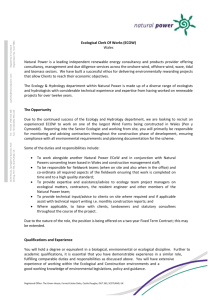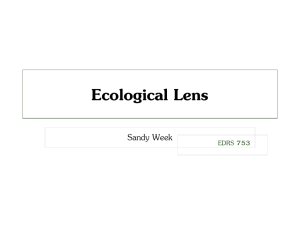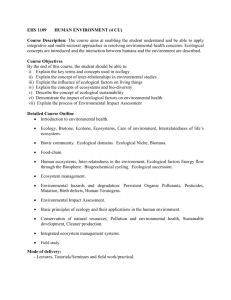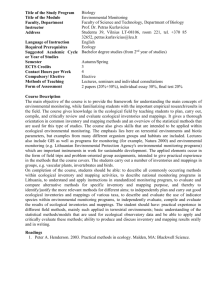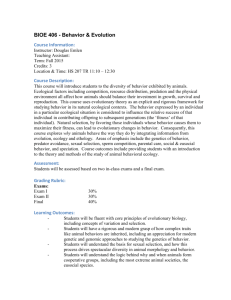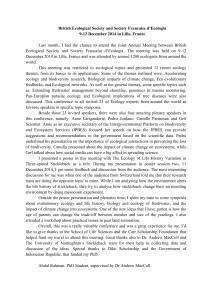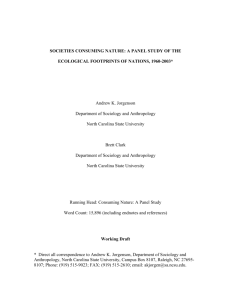WILD 7970 ADVANCED ANALYSIS FOR ECOLOGICAL SCIENCES
advertisement
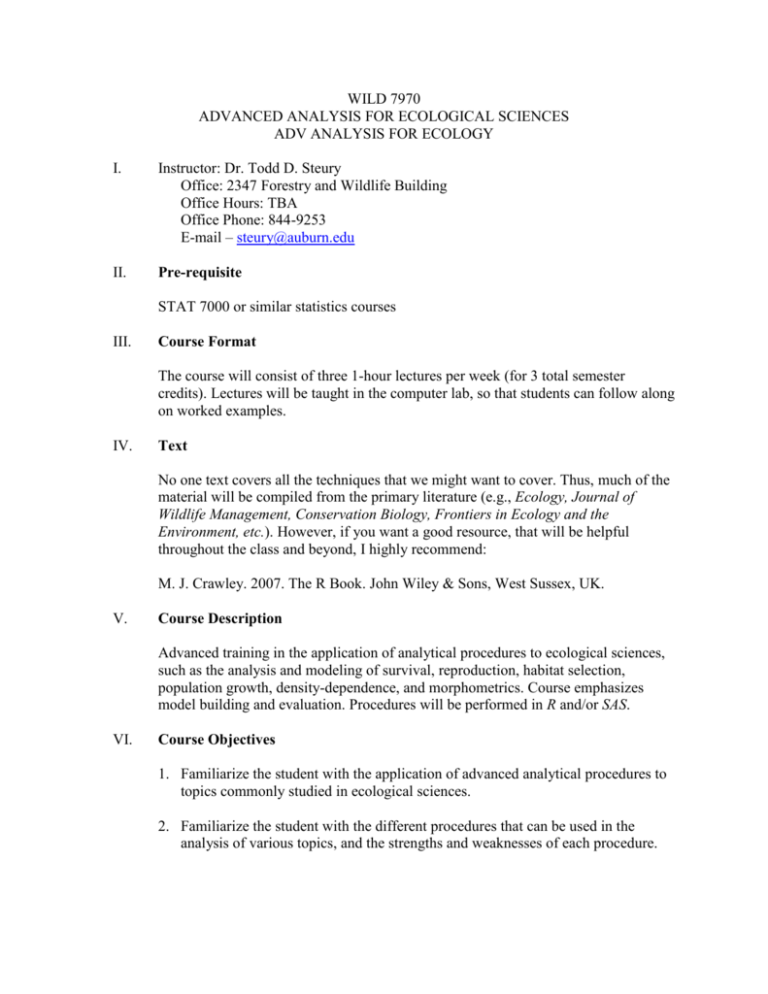
WILD 7970 ADVANCED ANALYSIS FOR ECOLOGICAL SCIENCES ADV ANALYSIS FOR ECOLOGY I. Instructor: Dr. Todd D. Steury Office: 2347 Forestry and Wildlife Building Office Hours: TBA Office Phone: 844-9253 E-mail – steury@auburn.edu II. Pre-requisite STAT 7000 or similar statistics courses III. Course Format The course will consist of three 1-hour lectures per week (for 3 total semester credits). Lectures will be taught in the computer lab, so that students can follow along on worked examples. IV. Text No one text covers all the techniques that we might want to cover. Thus, much of the material will be compiled from the primary literature (e.g., Ecology, Journal of Wildlife Management, Conservation Biology, Frontiers in Ecology and the Environment, etc.). However, if you want a good resource, that will be helpful throughout the class and beyond, I highly recommend: M. J. Crawley. 2007. The R Book. John Wiley & Sons, West Sussex, UK. V. Course Description Advanced training in the application of analytical procedures to ecological sciences, such as the analysis and modeling of survival, reproduction, habitat selection, population growth, density-dependence, and morphometrics. Course emphasizes model building and evaluation. Procedures will be performed in R and/or SAS. VI. Course Objectives 1. Familiarize the student with the application of advanced analytical procedures to topics commonly studied in ecological sciences. 2. Familiarize the student with the different procedures that can be used in the analysis of various topics, and the strengths and weaknesses of each procedure. 3. Train the student how to perform advanced analytical procedures using the computing languages R and SAS. VII. Course Requirements/Evaluation Students will be evaluated via assignments, quizzes, and a final exam. Assignments will include weekly reports detailing procedures learned and performed on example data and will count 50% of the total grade. The final exam, which will be comprehensive, will count for 30% of the total grade. The remaining 20% of the total grade will come from quizzes. Quizzes and exams will be short answer and multiple choice. The standard grading scale will be used (i.e., 90-100% = A; 80-90% = B; 7080% = C; 60-70% = D; <60% = F). VIII. Course Policies Students are expected to attend all lectures. IX. Academic Honesty Students should become familiar with the Student Academic Honesty Code that is published in the latest version of the Tiger Cub. Students in this class are expected to strictly adhere to this code, and any violations of the code will be brought before the Academic Honesty Committee. X. Justification for Graduate Courses This is an advanced course, requiring a solid understanding of basic statistics procedures. The prerequisite for this course would be STAT 7000 or similar. Students will learn to model ecological systems at a level equal to that used in ecological literature. Thus, the difficulty of the topics combined with the depth with which students will learn to apply them will ensure that graduate level credit is warranted. XI. Students with Disabilities Students who need special accommodations in class, as provided for by the American Disabilities Act, should arrange a confidential meeting with the instructor during office hours the first week of classes - or as soon as possible if accommodations are needed immediately. You must being a copy of your Accommodation Memo and an Instructor Verification Form to the meeting. If you do not have these forms but need accommodations, make an appointment with the Program for Students with Disabilities, 1244 Haley Center, 844-2096 (V/ TT) or e-mail: scw0005@auburn.edu. WILD 7970 ADVANCED ANALYSIS FOR ECOLOGICAL SCIENCES Lecture Outline Week Lecture Topics 1. Review of purposes of analyses; Intro to software; definitions 2. Review of basic statistics and relationship to ecological modeling (Review of ANOVA, regression, and relation to general linear models (GLM)) 3. Modeling effects of temperature and other covariates (Multivariate general linear models (ANCOVA) 4. Effects of sampled (rather than chosen) treatments (Random and mixed-effects ANOVA) 5. Analyses of animal and vegetative growth (Repeated measures ANOVA, nested ANOVA) 6. Analyses of survival and reproduction – Generalized linear models (Logistic regression, Poisson regression) 7. Analysis of sampling data – likelihood (Zero-inflated distributions) 8. Analyses of morphometric traits – variable reduction (Principle components analysis, ordination, factor analysis) 9. Which came first, the chick or the egg? Causality modeling (Path analysis, structural equation modeling) 10. General model evaluation and selection (AIC, partial likelihood ratio tests) 11. Multi-model inference 12. Testing for density-dependence in population time-series (Bootstrap, jackknife, Monte Carlo simulation) 13. Phylogenetic analyses (Bayesian analyses) 14. Students choice – Students choose the topics; students bring own data 15. Students choice – Students choose the topics; students bring own data




